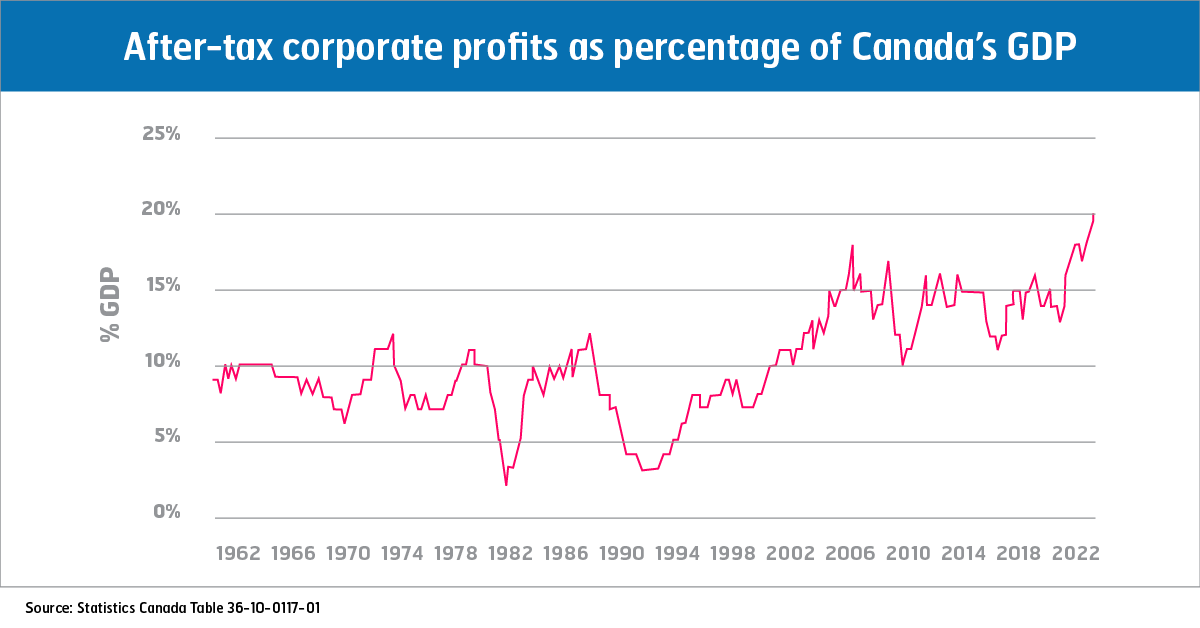通胀背后企业利润创历史新高
https://cupe.ca/record-high-corporate-profits-behind-inflation
2022 年 12 月 8 日
关于企业利润的公众争论越来越多——多少算太多? 在大流行期间,大企业取得了创纪录的收益,而家庭和小型企业则陷入困境。 随着通货膨胀的加剧,企业的逐利行为导致了物价的上涨。
加拿大央行基本上忽视了企业在制定价格方面所发挥的作用。 相反,它继续暗示提高工资将导致物价上涨(工资-物价螺旋式上升)。 例如,10月份央行加息时,9次提到工资,却根本没有提到企业利润。
这种做法是不诚实的。 我们可以看到,平均工资涨幅全面低于通胀,而企业利润却在增长。
事实上,作为加拿大国内生产总值(GDP)的一部分,企业税后利润已达到60年来的最高水平。 GDP 是一个国家在特定时期内制造的所有制成品和服务的货币价值。 它通常用于估计经济规模。 2022年第二季度(4月、5月和6月),企业税后利润占加拿大GDP的20%。 这比 2005 年金融危机前 18% 的高点高出两个百分点,是 1960 年至 2000 年间平均水平的两倍多。
为什么加拿大央行忽视企业利润在物价上涨中的作用? 原因之一是主流经济理论认为,企业自然会设定尽可能高的价格以实现利润最大化。 这个想法是,如果企业将价格定得太高,消费者就会转向更实惠的选择,从而控制价格。
问题是,这只有在市场存在良性竞争的情况下才有效,并且新企业可以通过以较低价格提供商品和服务来赚钱。 这在加拿大很困难,因为我们的法律有利于公司合并和垄断,使新企业更难竞争。
反竞争行为在加拿大并不新鲜,我们对此的担忧也不是新鲜事。 过去几年,公众对一些大型企业合并表示强烈抗议,联邦政府刚刚于 11 月启动了期待已久的竞争审查。 在整个过程中,我们需要让政府承担责任,以改进我们的竞争法并控制价格。
虽然竞争法的改进会有所帮助,但这并不是全部。 加拿大的一些行业也有多家参与者,例如加拿大的大银行,它们在竞争激烈的市场中维持的价格高于我们的预期。 这表明竞争并不是经济学家有时认为的神奇解决方案,尤其是在涉及住房、食物和能源等必需品和服务时。 企业知道消费者会为他们需要的东西支付更多的钱,即使他们真的买不起。 对于真正的必需品,有一个公共选择是有意义的,这样可以消除暴利——就像公共能源公司一样。
最后,值得注意的是,提高企业税后利润的主要驱动力之一是联邦和省级政府自 2000 年以来实施的大幅企业减税。这导致财富从 政府和公共服务落入私人手中。 我们需要我们的政府认识到这种滴入式方法已经失败,并在企业税收方面实现更好的平衡。
Record-high corporate profits behind inflation
https://cupe.ca/record-high-corporate-profits-behind-inflation
The Bank of Canada has mostly ignored the role that corporations play in setting prices. Instead, it has continued to suggest that raising wages will lead to higher prices (a wage-price spiral). For example, when the Bank increased interest rates in October, they mentioned wages 9 times, and failed to mention corporate profits at all.
Such an approach is disingenuous. We can see that average wage increases are lower than inflation across the board, while corporate profits are increasing.
In fact, as a share of Canada’s gross domestic product (GDP), after-tax corporate profits have reached a 60-year high. GDP is the monetary value of all finished goods and services made within a country during a given period. It’s often used to estimate the size of an economy. In the second quarter of 2022 (the months of April, May, and June), after-tax corporate profits accounted for 20% of Canada’s GDP. This is two percentage points higher than the pre-financial crisis high of 18% that we saw in 2005, and more than double the average we saw between 1960 and 2000.
Why is the Bank of Canada ignoring the role of corporate profits in rising prices? One reason is that mainstream economic theory says it’s natural for corporations to set prices as high as they can to maximize profits. The idea is that if corporations set prices too high, consumers will switch to a more affordable option, keeping prices in check.
The problem is that this only works if there is healthy competition in the market, and new businesses can make money by offering goods and services at lower prices. This is difficult in Canada because our laws favour corporate mergers and monopolies, making it harder for new businesses to compete.
Anti-competitive behaviour isn’t new in Canada, and neither are our concerns about it. There’s been public outcry over a number of large corporate mergers in the past several years, and the federal government just launched a long-awaited competition review in November. Throughout this process, we will need to hold the government to account to improve our competition laws and keep prices in check.
But while improvements to competition law will help, it’s not the whole picture. There are also Canadian industries with several players, such as Canada’s big banks, which maintain higher prices than we would expect in a competitive marketplace. This demonstrates that competition isn’t the magic fix that economists sometimes make it out to be – especially when it comes to goods and services that are necessities, like shelter, food, and energy. Corporations know that consumers will pay more for things that they need, even if they really can’t afford it. For true necessities, it makes sense to have a public option that takes profiteering out of the equation – like public energy companies.
Finally, it’s important to note that one of the primary drivers of higher after-tax corporate profits has been the dramatic corporate tax cuts that governments at both the federal and provincial levels have implemented since 2000. This has resulted in a huge transfer of wealth from governments and public services into private hands. We need our governments to recognize that this trickle-down approach has failed, and to implement a better balance in corporate taxation.
